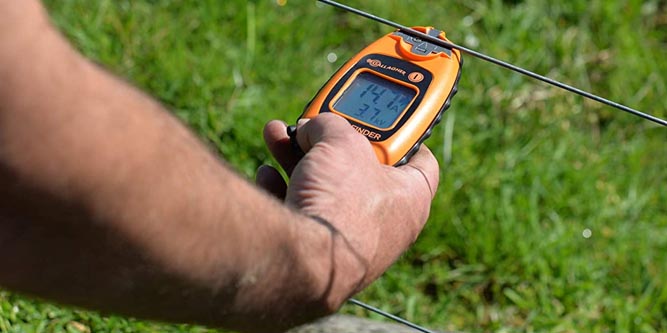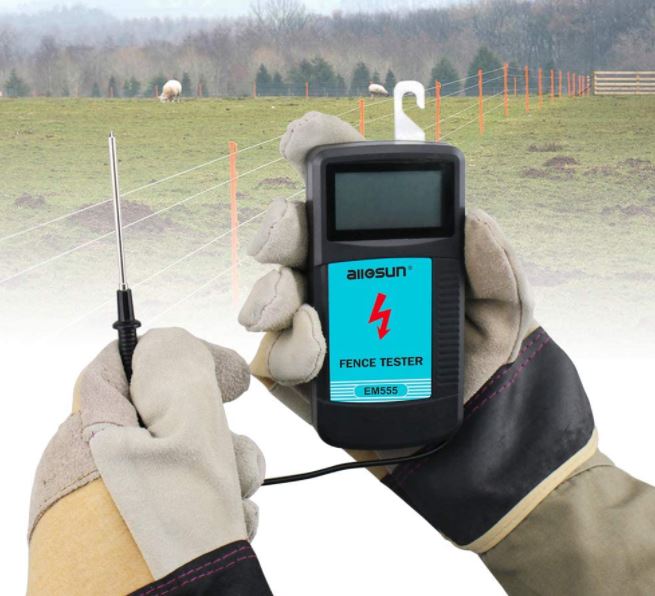Raising livestock presents a number of challenges. You have to worry about breeding, disease, and making sure all of your animals stay fed. And as we all know, this last part requires a whole lot of grazing. Unfortunately, animals don’t have a concept of “property lines” or “not wandering out in the road.” And for many animals, a simple fence presents not so much an insurmountable barrier as a minor annoyance. If you want to keep your cattle or other livestock confined to their pasture, an electric fence is a must.
Electric fences can be powered in a variety of ways. Ordinary grid power is the most obvious. But many people use deep cycle batteries and solar arrays for off-grid use, or simply as a backup. Whatever your power supply, though, you’ll inevitably need to do some troubleshooting. Electric fences, by their very nature, are exposed to the elements and abuse from large animals. At some point, they’re going to fail. When that happens, you can either walk miles of fence line looking for damage, or use a voltage tester. A voltage tester is a specially-designed voltmeter for use on electric fences.
Today, we’ll be looking at three of the best electric fence voltage testers available. We’ll begin by reviewing the Zareba FD1. This is a combination volt tester and short detector, which points you in the direction of any shorts. Next, we’ll examine the allsun EM555. This is an inexpensive tester with an attached ground rod. Last, we’ll look at the Gallagher G50900 SmartFix Fence Tester. This is a voltage tester and short detector with a retractable voltage probe. Which one is the best for you? To find out, we’ll need to take a closer look, and compare all of their features. Let’s see how they stack up!
How Much Voltage Should I Use?
Before you start testing your voltage, it’s important to establish some parameters. Specifically, how much voltage are you supposed to have? Ideally, you’ll already know, but this may not be the case. If you’re not sure, think about the type of animal you’re trying to retain. The larger and more aggressive the animal, the more voltage you’ll need. For example, an electrified poultry fence will usually max out at around 500 volts. It just doesn’t take much of a shock to deter a chicken.
The most common usage of electric fencing is for cattle or horses. In this case, you’ll need about 2,000 to 3,000 volts for your fence to be effective. The reason there’s such a wide range is that weeds and vegetation absorb some of the voltage. If your fence line is neatly trimmed, a 2,000-volt charge should be sufficient. If there’s a lot of brush around your fence, you’ll want closer to 3,000 volts. Keep in mind that bulls can get very determined when they smell a cow in heat. If you’re pasturing a bull separately, you’ll need to use a more powerful fence. To deter an aggressive bull from simply breaking through, a charge of 4,000 volts is recommended.
Similarly, predators are often willing to tolerate a high voltage for the reward of an easy meal. Wolves are determined enough that it requires a 4,000-volt fence to keep them out – the same as a bull! Bears and mountain lions require even more voltage. If you want to keep a full-grown grizzly from raiding your apiary, you’ll need a 7,000-volt fence. Remember that voltage can drop as you get too far from your power supply. To make sure your entire fence is up to snuff, check as far as you can from your battery.

Troubleshooting Electric Fence Voltage Issues
Let’s assume your electric fence is indeed under voltage. How do you find the problem? Here’s a quick troubleshooting guide. We’ll start with the easiest solutions, and work our way up to more involved steps.
Start by Checking the Power Supply
Under most circumstances, your power supply is going to be on an easily-accessible part of your fence. It’s also a common point of failure, so let’s check that first. How you check your power supply will depend on what type of power you’re using. For AC power, simply unplug your power supply and plug something else into the outlet. If you plug in a light and it works immediately, you know the outlet is fine. If not, check your breaker box and proceed from there as needed.
For solar or battery-powered systems, things get a little bit more complicated. You need to use an ordinary voltmeter to check the power from the solar panel or battery system. For batteries, you may be running either 6 or 12 volts depending on the power supply. Make sure you know what the system’s voltage is before you test it. Keep in mind that some 12-volt systems use a pair of 6-volt batteries. On these systems, check both batteries individually. Then check the entire circuit to make sure you’re getting a full 12 volts. If you’re not, you probably have a corroded wire.
Another thing is to keep in mind is that solar charger batteries are usually rated for about three years. They can last longer in warm climates, and may fail sooner in cold climates. Regardless, if you’ve got an older battery, it’s perfectly normal to see a drop in voltage. In that case, nothing is “broken,” per se. Your battery has just worn out and needs to be replaced.
Test Your Terminals
Assuming your energizer is getting enough power, the next step is to make sure it’s putting out enough power. First, shut off the power! You don’t want to zap yourself while performing your test. Now, disconnect both hook-up wires from the energizer, and turn the power back on. Now, using your voltage tester, check the output on the positive terminal. The exact reading you’re looking for will depend on your energizer’s manufacturer. Check your owner’s manual to find out how much voltage you should be reading. It can be anywhere from a few hundred to 10,000 volts, depending on what you’re using.
Check Your Ground Rod
Assuming your energizer is putting out enough voltage, the next thing to check is your ground rod voltage. Power off your fence, reconnect all your wires, and turn the energizer back on. Now, check the voltage on the ground rod wire using your voltage checker. Again, you’ll need to consult your owner’s manual, since every energizer will have a different ground rod voltage.
If your ground rod is under voltage, it’s most likely not damaged. The most common cause of ground rod failure is dry, rocky, or sandy soil that’s not very conductive. Oftentimes, the easiest solution is to add more ground rods. Add a second rod, then check the voltage to see if it adds up to your manufacturer’s recommendations. If that doesn’t work, install a third rod, and so on.
Test Your Hook-Up wires
The hook-up wires are the short lines that connect your energizer’s positive and negative terminals to the fence. These are a common point of failure, since they can easily get disconnected or damaged. They can also easily become grounded by accident. To test your hook-up wires, first turn off your energizer, then check all of your connections. If you’ve just tested your terminals and ground rod, you’ve already messed with these today. But double-check your work just to be sure everything’s connected properly. Turn your power back on, and check your fence voltage.
If you’re still not getting enough power, turn the power off, disconnect one hook-up wire, and power back on. Test the wire to see if it’s within your manufacturer’s recommendations – again, you’ll have to check your manual. Repeat the process for the other hook-up wire. If you still can’t identify any issues, reconnect both wires and power your fence back on. You’re going to have to check the entire wire.
Test Your Fence Voltage
If all else fails, you’ll have to walk your entire fence line to find the source of your problem. Turn on your energizer, put on your best walking boots, and start walking. As you go, you’ll want to check your line about every 100 feet. If there’s a sudden drop in voltage, you’ll know you’ve just passed the source of your problem. Back up 50 feet, test again, and see if there’s still a drop. Keep moving forwards or backwards as necessary, and you’ll soon locate your issue.
Remember that it’s normal for voltage to drop off as distance from the energizer gets farther. You’re not looking for this ordinary, steady drop. You’re looking for the place where your voltage drops off a cliff. If there’s no such sudden dropoff, you may simply be running too long a wire on too little power. Consider upgrading your power supply, or dividing the fence into two sections with two separate supplies.
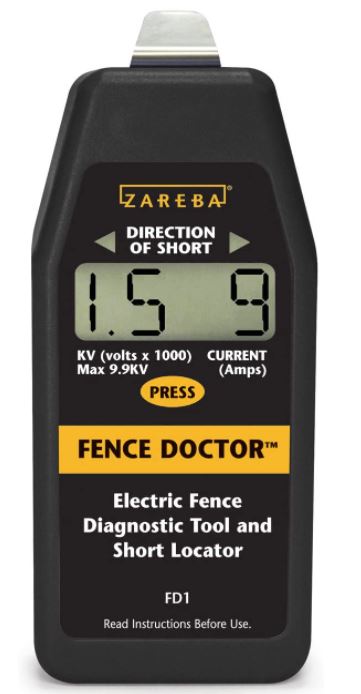
Zareba FD1
The Zareba FD1 is a handheld fence voltage tester with a rugged black polymer case. It measures 8.25 inches long, 4 inches wide, and 1.6 inches thick, so it’s like a fat smartphone. At 7.2 ounces, it’s relatively lightweight and easy to handle. To operate it, you simply place the metal tip over the wire, and press the bright yellow button.
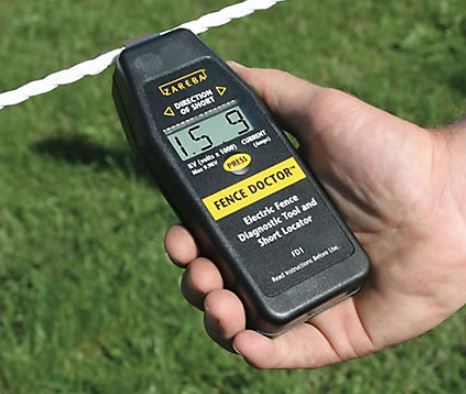
The digital display will read any voltage from 200 to 9,900 volts, and will also show your amperage. However, the thing that sets the FD1 apart from our other two choices is the short detection. This tester doesn’t just tell you when there’s a short. It actually points in the direction of the short. This can save you a bunch of troubleshooting by helping you find your issues faster.

allsun EM555
The allsun EM555 is a more basic voltage tester for people who want a simpler device. The black plastic housing measures 8.5 inches long, 4.65 inches wide, and 2.01 inches thick. With a weight of 10.3 ounces, it’s both larger and heavier than the Zareba, but not by much.
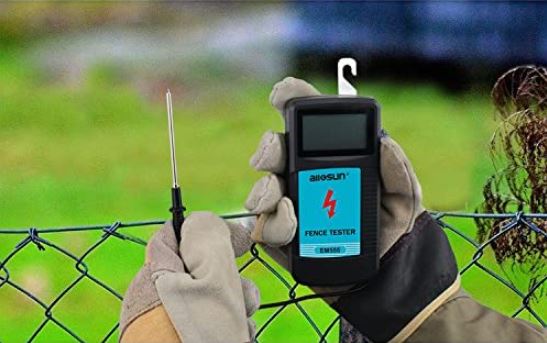
The back of the housing sports a metal hook, which you hang over your fence wire. You then insert the probe into the ground, and it displays a voltage reading. It will measure anywhere from 300 to 9,900 volts, so it has almost as wide a range as the Zareba. The EM555 also includes a carrying case, and is covered by a 12-month manufacturer’s warranty. On the downside, it doesn’t offer any short detection. You’ll need to find any shorts yourself based on the voltage dropoff.
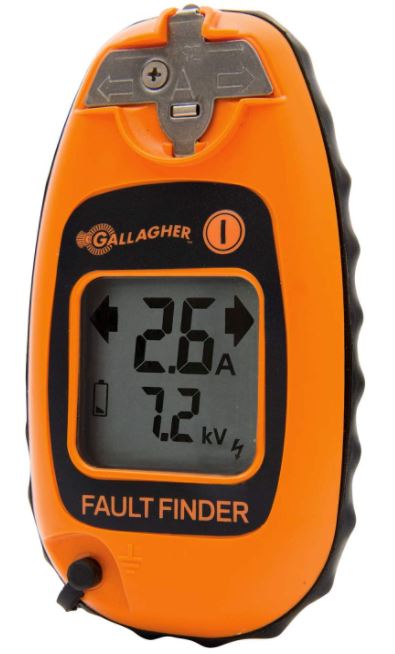
Gallagher G50900 SmartFix Fence Tester
The Gallagher G50900 SmartFix Fence Tester is the most compact on our list. Smaller than a smartphone and only 7.4 ounces in size, it can be carried in your breast pocket. The front of the housing features a conductive plate, which you touch to your wire. You then put the ground rod in the ground, and read your voltage and amperage. The range of this tester is very wide, from 100 volts up to 12,000. There’s also a retractable voltage probe to help you access hard-to-reach wires.
Final Verdict
Which one of these voltage testers is the best will depend on your needs. The Zareba FD1 is, for most purposes, the most full-featured of the bunch. In addition to a wide voltage range, it also points you in the direction of shorts. Combined with an easy-to read screen, an amperage readout, and a compact design, there’s a lot to like.
The allsun EM555 is a simple volt tester that doesn’t check for shorts. That said, it’s very affordable, only a fraction of the price of our other two options. Even so, it’s well-engineered, and comes with a carrying case. And it has almost as wide a range as the Zareba tester, so it can be used for a variety of fences.
The Gallagher G50900 SmartFix Fence Tester has the widest range of any of our options. Measuring between 100 and 12,000 volts, it can measure just about any fencing system. It also has a compact design, small enough to carry in your pocket. On the other hand, it costs as much as the Zareba, without the benefit of specialized short detection.
Meet Ry, “TechGuru,” a 36-year-old technology enthusiast with a deep passion for tech innovations. With extensive experience, he specializes in gaming hardware and software, and has expertise in gadgets, custom PCs, and audio.
Besides writing about tech and reviewing new products, he enjoys traveling, hiking, and photography. Committed to keeping up with the latest industry trends, he aims to guide readers in making informed tech decisions.

